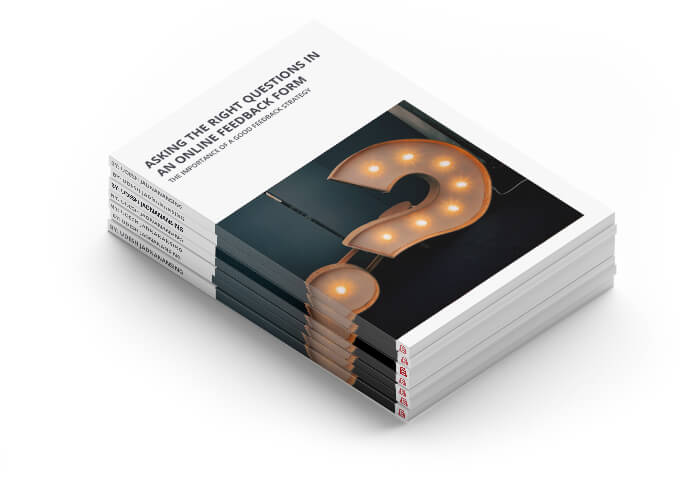Website feedback analytics provides insight into what your visitors experience on your website. It is a critical supplement to other tools used to analyse (click) behaviour, such as Google Analytics. With user feedback, you get insights into how your customers experience your website. In other words, website feedback analytics explains the story behind the click behaviour of your visitors.
There are different types of online customer feedback software for websites and mobile apps: from simple tools with which you can easily collect customer feedback to more extensive analysis tools, including customisable dashboards (data visualisation) and text analysis. There is something for everyone, but it is, however, important to determine what you want to achieve exactly with your feedback project. Customer feedback analysis gives your company a clear overview of what exactly must be changed and what you can improve upon – if you do it the right way, of course.

Free White Paper: The importance of A good Feedback Strategy
Learn about asking the right questions in an online feedback form to get the most out of it.
To help you find your way, we’ve identified three different advantages of Feedback Analytics software:
1. Feedback analytics provides insight into trends
Following trends is probably one of the most important parts of analysing customer feedback. Trends show why processes go wrong. Long term trends, in particular, help you determine statistical deviations or a key trend that you should look into immediately.
If you zoom in on individual feedback items, you will probably see many complaints and angry comments. Try not to dwell on these items, but rather focus on the bigger picture. Improve the most important bottlenecks in the customer journey and see what the effect is on value and conversion.

2. Filter and compare
Feedback analytics helps you easily map out large amounts of feedback data. Using feedback analytics, you can visualise, among others, scores in charts and widgets. You decide which data you will visualise and how you want to set up your feedback dashboards.
You can also calculate feedback metrics in various ways. For example, Net Promoter Score (NPS) or Customer Effort Score (CES). Combine this data with pre-existing data, such as the date or time period, the page where the feedback comes from, the browser or the operating system of the user or device. This answers questions such as:
- Which pages do we get the most feedback on
- What do our visitors think of this page – how good/bad?
- Which subjects come up often in feedback (bugs, compliments, suggestions, etc.)?
- How do different browsers rank among each other?
- On which devices do we receive the most error messages?
Of course it is necessary to have insight into these kinds of things. After all, you want to improve your website. But you also want to know why a page, for example, gets a lower score. Therefore, you should also be looking at the underlying comments. The real cause (also known as the root cause) often lies hidden among these comments. This combination of quantitative insights (scores, numbers, etc) and qualitative data (open feedback comments) make Feedback Analytics software so valuable.
3. Let automated text analysis do the work
Firstly, what is text analysis? Text analysis is the way of knowing what’s going on among your customers. With text analysis, not only are you able to identify the small issues, but you can uncover the entire customer journey. A few possibilities revolving around text analysis:
Word frequency: This is the simplest form of text analysis, whereby commonly used words are counted.
Word grouping: Extracting insights from common word combinations (for example, “problems” + “login” + “reset” + “password”)
Sentiment analysis: Using the above techniques, you can determine which words are used most often and with which other words they’re combined with most often. A sentiment analysis gives you an indication of the context in which your customers use the words and if this leads to, for example, irritation or frustration. With automated sentiment analyses you get a broad understanding of the sentiment behind the feedback topics that come up often and whether commonly used words are used in a positive or negative context.
Categorisation of comments: Techniques such as machine learning help you automatically group open comments. If you set this process up properly, you will see what the most common topics are within your feedback. The system recognises many common topics and groups them based on the open comments. With machine learning, you can give the system feedback if the responses are classified correctly. The software “learns” from the continuous feedback from users (if the system has classified the comments correctly or incorrectly), so that overtime the categorisation improves and it becomes easier to extract insights from these large amounts of feedback data.

In conclusion
Have you extracted important insights from your website feedback analytics? Keep in mind that these insights are only valuable if you actually take action. Feedback analytics packages typically provide tools that help convert insights into effective action. That’s how you go from insight to action!
Ready to see Mopinion in action?
Want to learn more about Mopinion’s all-in-1 user feedback platform? Don’t be shy and take our software for a spin! Do you prefer it a bit more personal? Just book a demo. One of our feedback pro’s will guide you through the software and answer any questions you may have.






